Hubsan HBS24G131111 RC Hobby Series User Manual H202
Hubsan (HK) Industrial Co., Ltd. RC Hobby Series H202
Hubsan >
user manual
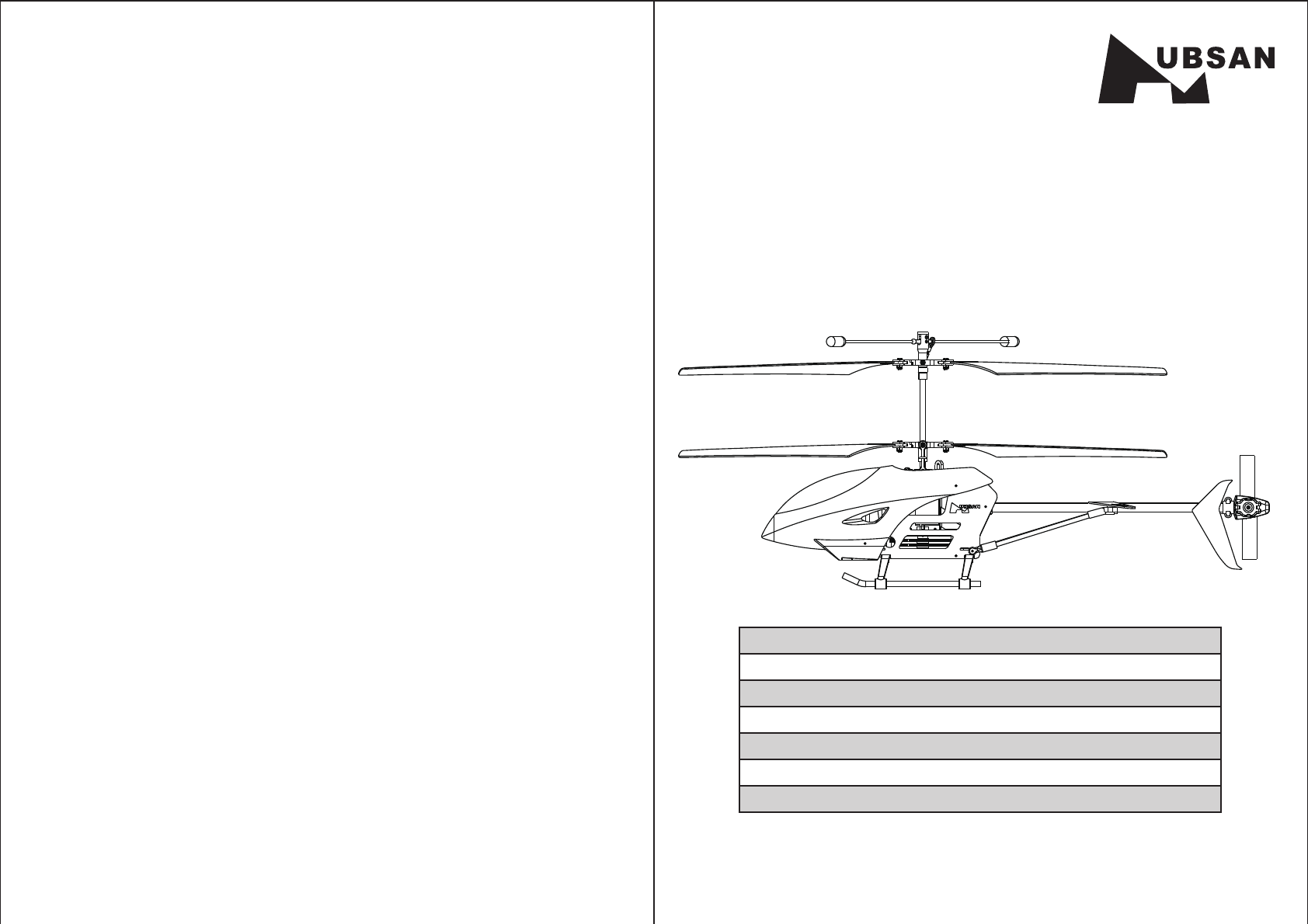
>INTRODUCTION
>SAFETY NOTES
>SAFETY CHECK BEFORE FLYING
>TRANSMITTER SETUP
>INSTRUCTION FOR BATTERY RECHARGING
>FLYING TRAINING
CONTENTS
INSTRUCTION
MANUAL
™
No.H202

1 INTRODUCTION
2 SAFETY NOTES
Thank you for buying HUBSAN products. The helicopter is designed as an easy to
use, full featured RC helicopter model capable of all forms of rotary flight. Please read
the manual carefully before assembling the model, and follow all precautions and
recommendations within the manual. Be sure to retain the manual for future
reference, routine maintenance, and tuning.
1.1 IMPORTANT NOTES
This RC helicopter is not a toy, it utilizes various high-tech products and technologies
to provide superior performance.
Please read this manual carefully before operating this product. Improper use of this
product can result in serious injury. Be aware of your personal safety, safety of others
and your surrounding environment.
We recommend that you obtain the assistance of an experienced pilot before
attempting to fly our product for the first time.
2.1 CAUTION
R/C helicopters have parts that move at high speed, thus posing a certain degree of
danger. Pilots are responsible for any actions resulting in damage or injury from the
improper operation of their R/C aircraft models.
Choose a wide open space without obstacles. Do not operate R/C aircraft near
buildings, crowds of people, high voltage cables, or trees to ensure the safety of
yourself, others and your model.
Operate this unit within your ability. Do not fly whilst tired, improper operation may
cause in danger.
2.2 LiPo Battery Recharging
Your helicopter is powered by a Lithium-Polymer (LiPo) battery.
Never recharge your battery whilst it is inserted in your model. It can catch fire leading
to the total destruction of the item.
118
Remember, your helicopter is designed for indoor operation, where low-speed
precision-control is paramount. When flying in the great outdoors - even though you
may think it’s absolute flat calm - you will notice that your helicopter is susceptible to
almost imperceptible air currents. This presents an interesting challenge for the
experienced pilot, but could spell disaster if attempted too soon. So, take your time
and practice the Flying Lessons described in this manual until you have acquired
proficiency in the Advanced Maneuvers.
Make sure it really is a flat calm day outside. And remember that outdoor flight is a
whole new learning experience.
Flying your radio-controlled helicopter outdoors really is great fun. Just remember its
design limitations and be prepared to make the professional pilot’s decision to cancel
your plans and you helicopter will live to fly another day.
There are Old pilots, and there are Bold pilots……
But, there are no Old Bold pilots!
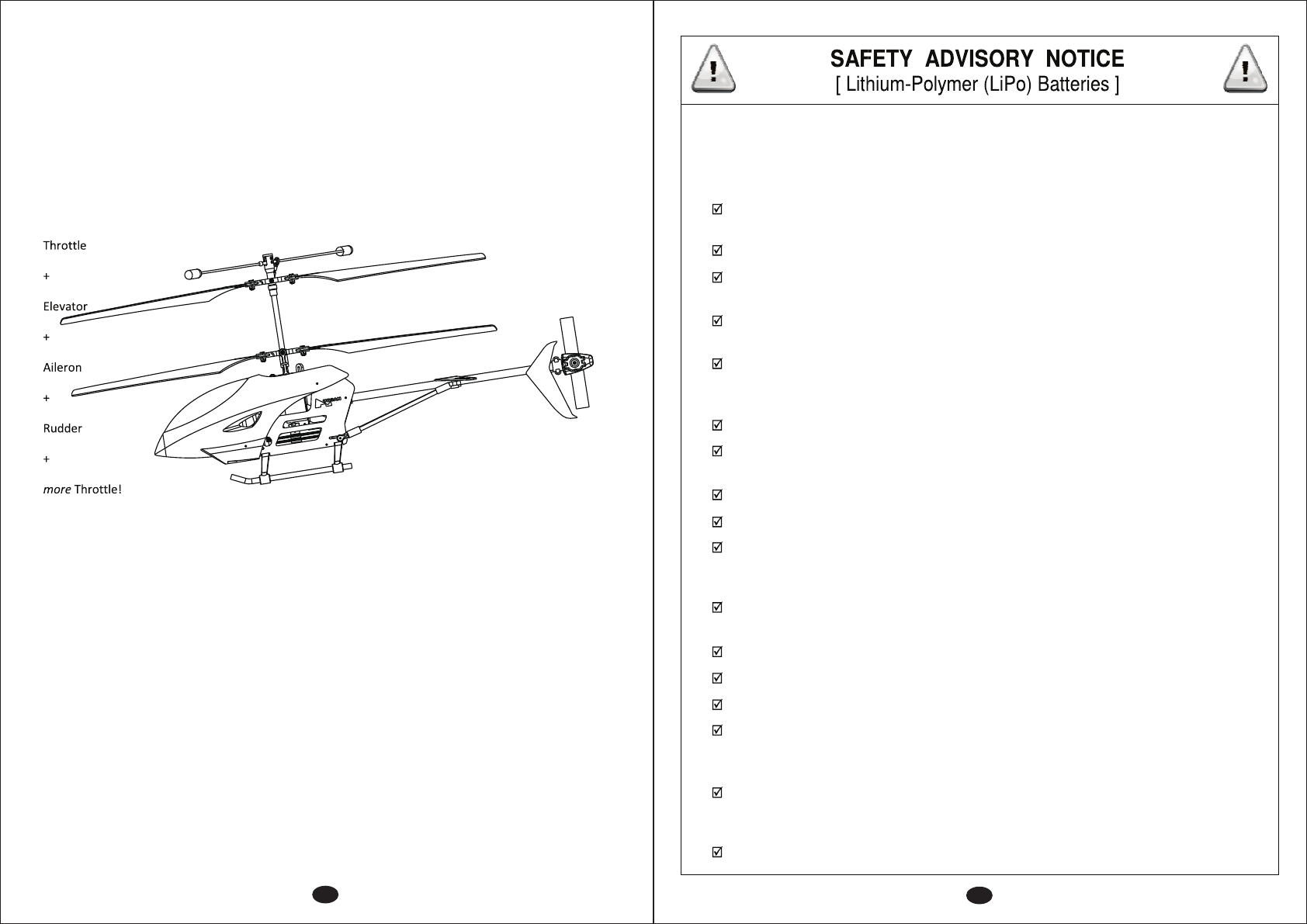
2
Charge and store LiPo batteries in a location where a battery fire or
explosion (including smoke hazard) will not endanger life or property
Keep LiPo batteries away from children and animals
Consider how you would deal with a LiPo battery fire/explosion as part of your
normal home Fire Safety & Evacuation Planning
Never charge a LiPo pack that has ballooned or swelled due to
over-/under-charging or from a crash
Never charge a LiPo battery pack that has been punctured or damaged in a
crash (After a crash, inspect the battery pack for the sign of damage. Discard
in accordance with your country’s recycling laws.).
Do not charge LiPo batteries near flammable materials or liquids
Ensure that charging leads are connected correctly. Reverse polarity charging
can lead to battery damage or a fire or explosion
Never charge a LiPo battery in a moving vehicle
Only charge your LiPo battery using the supplied “balanced” charger
Have a suitable(electrical type) fire extinguisher near the charging area OR a
large bucket of dry sand. Do not try to extinguish electrical (LiPo) battery fires
with water
Reduce risks from fire/explosion by storing and charging LiPo batteries inside
a suitable container: a LiPo Sack or metal/ceramic container is advised
Monitor recharging LiPo batteries for signs of overheating
Never over charge a LiPo battery
Never leave a LiPo battery unattended during recharging
Protect your LiPo battery from accidental damage during storage and
transportation. (Do not put battery packs in pockets or bags where they can
short circuit or can come into contact with sharp or metallic objects.)
If your LiPo battery is subjected to a shock (such as a helicopter crash) you
should place it in a metal container and observe for signs of swelling or
heating for at least 30 minutes
Do not attempt to disassemble or modify or repair a LiPo battery
LiPo batteries differ from conventional batteries in that their chemical contents are
encased in a relatively insubstantial foil packaging. This has the advantage of
significantly reducing their weight, but does make them more susceptible to
damage if roughly or inappropriately handled. As with all batteries, there is a risk
of fire or explosion if safety practices are ignored:
17
5. Don't forget to be ready to catch the helicopter's loss of lift. As you servos are
creating a battery power drain, you will need to increase the collective Throttle while
maintaining the Rudder input Exiting the Turn maneuver
6. At the end of the turn, begin to SUMULTANEOUSLY ease off the cyclic Roll,
collective Rudder and the additional Throttle inputs. You should practice until you
can simultaneously use all of the joystick inputs in smooth, synchronized
movements. This will take a lot of practice!
6.7 Flying Outdoors
These inputs will result in your model adopting a nose-down right-roll attitude. Note
that the top rotor remains almost horizontal (as a result of the gyroscopic stabilizer
arm), while the servos have pushed the swash plate to tilt the lower rotor
right-and-forwards in the intended direction of travel.
Tip- if you become confused, releasing your helicopter’s controls will bring it to a stop.
It will not lose height, as the Throttle is on a ratchet.
The effect of simultaneous control inputs will, with practice, result in elegant slip-free
turns which demonstrate the sophisticated controls of your 4 channel RC helicopter.
The final challenge is to fly your helicopter outdoors under open skies!

3
2.3 PREVENT MOISTURE
R/C models are composed of many precision electrical components.
It is critical to keep the model and associated equipment away from condensation and
other contaminants. Exposure to water or moisture may cause the model to
malfunction resulting in loss of responsiveness, or a crash.
2.4 PROPER OPERATION
For the safety purpose, please only use hubsan’s spare parts for replacement.
2.5 ALWAYS BE AWARE OF THE ROTATING BLADES
When in operation, the main and tail rotor blades will be spinning at high speed. The
blades are capable of inflicting serious body injury and damage to the environment.
Be cautious of your actions and careful to keep your body and loose clothing away
from the blades. Never take your eyes off the model or leave it unattended while it is
turned on. Once landed, immediately turn off the model and transmitter.
2.6 AVOID FLYING ALONE
Beginners should avoid flying alone whilst learning flight skills. It is advised that an
experienced pilot be on hand for guidance.
It is recommended to practice with a computer-based flight simulator.
CAREFULLY INSPECT BEFORE REAL FLIGHT
• Before operation, please check the batteries of the transmitter and receiver are
charged enough for the flight.
• Before turning on the transmitter, please check that the throttle stick is in the
minimum position.
• Check for any missing or loose screws and nuts. Carefully check main rotor blades
and rotor holders. Broken or premature failure of parts will result in a dangerous
situation.
• Check all the ball links to avoid excess play and replace as needed. Failure to do so
will result in poor flight stability.
• Check the battery and power plug are securely fastened. Vibration and violent flight
may cause the plug to loosen resulting in loss of control.
• When turning on the unit, please follow the power on/off procedure: for Power ON-
please turn on the transmitter first, and then turn on the receiver. For Power OFF-
please turn off the receiver first and then turn off the transmitter. Improper procedure
may cause loss of control of the helicopter.
3 SAFETY CHECK BEFORE FLYING
16
4. Notice that the cyclic joystick is spring-loaded, you must maintain a forwards
pressure on the cyclic joystick otherwise it will return to its neutral position and your
helicopter will stop moving.
Tip-if you become confused, releasing your helicopter's controls will bring it to stop. it
will not lose height as the throttle is on a ratchet.
5. Stop you helicopter, turn it around (use rudder), and bring it back.
6. Choose a landing site. Fly your helicopter to a position that is precisely over your
chosen landing site and set your helicopter down in a smooth and precise landing.
7. Repeat this flying lesson until you become S-M-O-O-T-H-L-Y proficient and
precise.
3.5 Advanced Maneuvering
In this flying lesson you will combine cyclic joystick Pitch and Roll inputs with collective
Rudder and Throttle inputs to give more precise control to your helicopter maneuvers.
You've probably already tried combining Rudder and forward Pitch inputs. This
combination allows you to turn your helicopter, but it won’t look right. The helicopter
will remain upright. It's like watching a bicycle that's not leaning into the turn, because
air has very little grip, your helicopter will actually skid through its turn.
The solution is to make the helicopter lean-"Roll"-so that rotors help to counteract the
tendency to skid (or 'side slip').To do this, you must learn to synchronise your use of
mixed Pitch and Roll on the cyclic joystick, with mixed Rudder and Throttle on the
collective joystick
1. Begin a hover at shoulder height.
2. Push the cyclic stick Forwards to gather sufficient airspeed.
3. Begin your turn by pushing the cyclic joystick to the right (setting up the Roll) while
maintaining forward pressure.
4. As your model begins to respond to the Roll, push the collective Rudder joystick to
the right to initiate the turn.
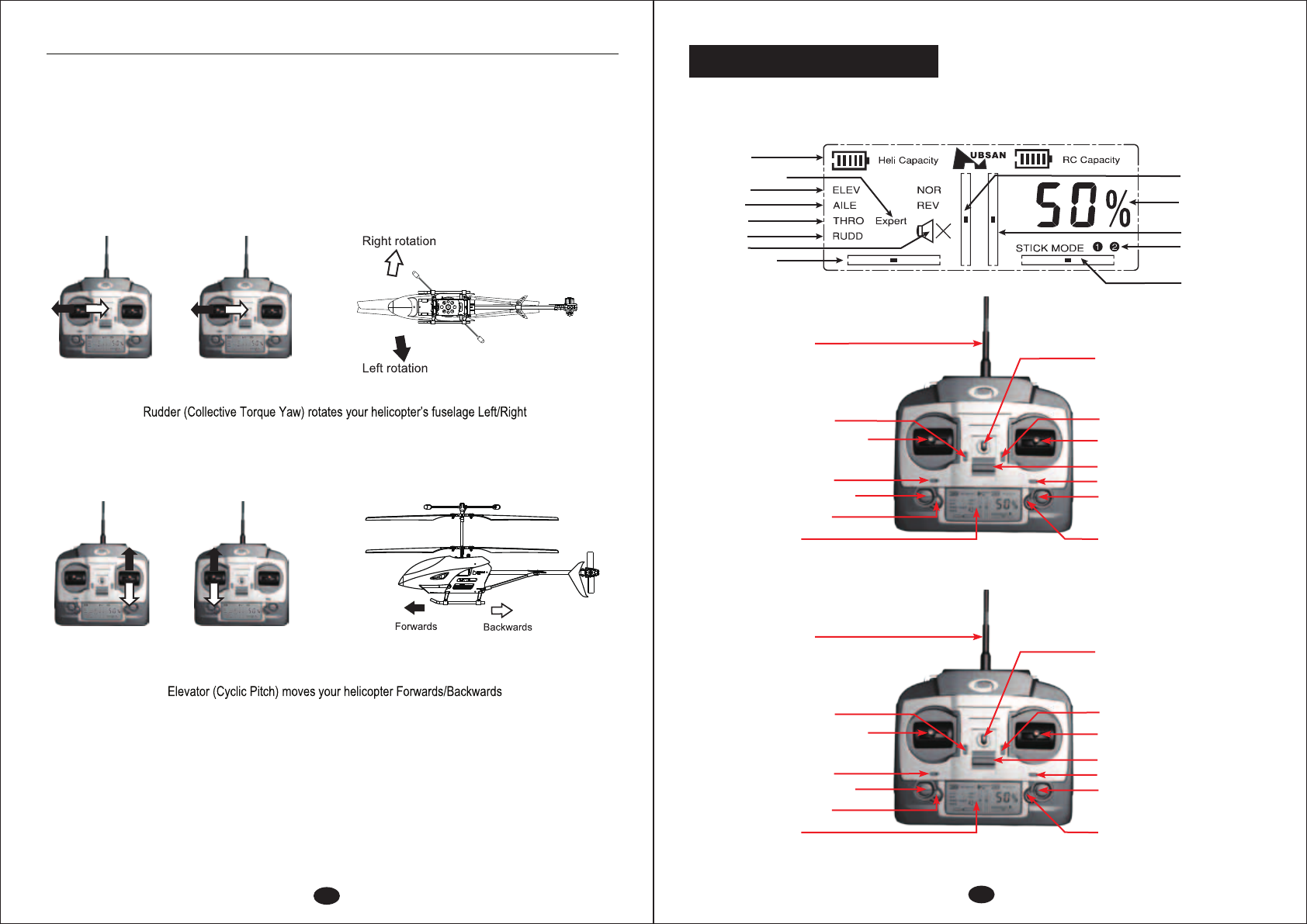
4
4 TRANSMITTER
4.1 Identification and functional keys
Battery voltage
display
Elevator
Aileron
Throttle
Rudder
Buzzer
Rudder trim
Elevator trim
Stick modes
display
Data display
Throttle trim
Aileron trim
Expert modes
9 Antenna
6 Throttle Trim
1 Throttle/Rudder Stick
5 Rudder Trim
UP Function
EXT Function Key
LCD
8 Neck Strap Eyelet
4 Elevator Trim
2 Elevator/Aileron stick
7 Power SW
3 Aileron Trim
ENT Function Key
Down Function
9 Antenna
4 Elevator Trim
(2) Elevator/Rudder Stick
5 Rudder Trim
UP Function
EXT Function Key
LCD
8 Neck Strap Eyelet
6 Throttle Trim
(1) Throttle /Aileron stick
7 Power SW
3 Aileron Trim
ENT Function Key
Down Function
TRANSMITTER
Main Menu
(MODE 2)
(MODE 1)
15
6.4 Basic Maneuvering
In this Flying Lesson you will use the cyclic joystick and the Rudder to maneuver
your helicopter.
1.Keeping a safe 1 to 2 meters from your model, S-M-O-O-T-H-L-Y advance the
collective Throttle joystick until your helicopter reaches approximately shoulder
height.
2.S-L-O-W-L-Y apply collective Rudder control to point the nose of your helicopter in
the direction you wish to fly.
3.Once you have turned your helicopter, place your right thumb over the tip of the
cyclic joystick and S-L-O-W-L-Y press forwards.
The lower rotor will tilt forward. The helicopter’s nose will pitch down. Your helicopter
will begin to move forward.
Tip- Be ready to slightly increase your Throttle power, as the helicopter is likely to
lose a little height during maneuvering. Also remember that the swash plate on the
helicopter links all of your cyclic controls; so don't be surprised if your helicopter
moves slightly to the left/right as well as forwards. As you gain experience, you will
stop thinking in terms of Left/Right or Forwards/Backwards and start to automatically
synchronize cyclic joystick corrections, just like flying a full size helicopter.
EXT
UP
ENT
DOWN
(MODE 2)
EXT
UP
ENT
DOWN
(MODE 1)
EXT
UP
ENT
DOWN
(MODE 2)
EXT
UP
ENT
DOWN
(MODE 1)
Tip: The helicopter will find the rudder central
automatically in 3 seconds after the helicopter
landing on the ground.
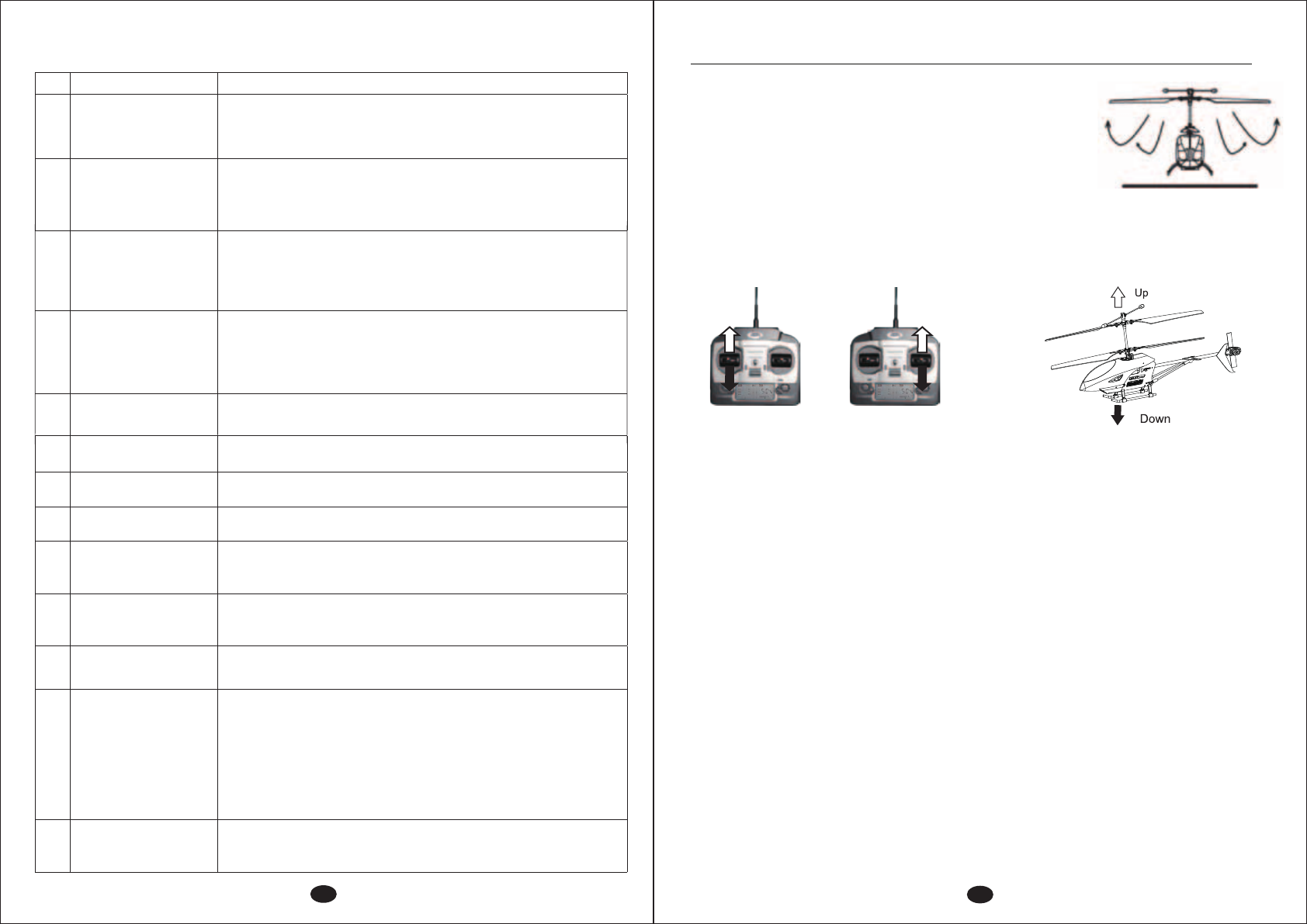
5
Input Key Function
S/N Identification Function
1 Throttle/Rudder Stick
2 Elevator/Aileron Stick
Forward and backward movement of the stick makes the helicopter
move forward and backward respectively. Left and right movement of
the stick makes the helicopter drift sideways left/right respectively.
(1) Throttle /Aileron stick
Forward and backward movement of the stick makes the helicopter
ascend and descend respectively. Left and right movement of the
stick makes the helicopter drift sideways left/right respectively
(2) Elevator/Rudder Stick
Forward and backward movement of the stick makes the helicopter
move forward and backward respectively. Left and right movement
of the stick will rotate the helicopter's fuselage left/right respectively.
3 Aileron Trim Aileron trim subsidiary adjusts left and right drift.
4 Elevator Trim Elevator trim subsidiary adjusts forward and backward movement.
5 Rudder Trim Rudder trim subsidiary adjusts left and right rotation.
6 Throttle Trim Throttle trim subsidiary adjusts ascent and descent.
7 Power SW Pushing up switches on the power transmitter, pulling down
switches it off.
8 Neck Strap Eyelet For the attachment of a neck strap which eases the tension of your
hands from holding the transmitter.
9 Antenna Transmits wireless signal
10 CHG
(Optional)
11 DSC (Optional) Connects to the data cable of computer simulator.
Forward and backward movement of the stick makes the helicopter
ascend and descend respectively. Left and right movement of the
stick will rotate the helicopter’s fuselage left/right respectively.
Can be used to charge the rechargeable battery pack (excluded)
inside the transmitter (at charge current 50mA, Voltage ≤ 12V.)
Notice: It is dangerous to charge a non-rechargeable battery
pack via this charge port.
It is dangerous to use the accompanied wall adapter as a DC
power supply.
14
6.3 Hovering and Cyclic Trim
Because your helicopter’s rotors create a ‘downdraft’ any
attempt to hover at too low an altitude (height) is more
difficult than hovering a little higher. This difficulty is
because the downdraft from your rotors is bounced back off
the ground, resulting in turbulent air around the
helicopter-this is referred to as ‘Ground Effect’. For this
reason, we recommend that you begin your hovering
practices at about 1 meter off the ground.
1. Keeping a safe 1 to 2 meters from your model, S-M-O-O-T-H-L-Y advance the
collective Throttle joystick until your helicopter reaches approximately waist height.
Throttle(Collective Power)Increases/decreases the Flying Height of your helicopter
2.If the helicopter has a tendency to rapidly move in any direction, either:
a.LAND IMMEDIATELY, by S-M-O-O-T-H-L-Y reducing the throttle power. Then
adjust the trim sliders to compensate. Repeat the sequence from Step1, above.
b.GENTLY apply cyclic joystick correction in the opposite direction to the
helicopter’s aberrant movement. Once you’ve established the amount of required
control correction, land your helicopter. Adjust the trim sliders equivalent to the
amount of the applied joystick compensation. Repeat this sequence, beginning at
Step1, above.
3.GENTLY and S-L-O-W-L-Y push forward/pull back on the collective Throttle to
maintain an even height without ‘bouncing’ the helicopter up and down.
Tip: for more sensitive control-and improved ability to mix Throttle and Rudder
inputs-try placing your left thumb on the tip of the collective joystick.
4.S-L-O-W-L-Y reduce the Throttle power and GENTLY land your helicopter.
5.Repeat the exercise, from Step 1 until you can confidently lift, hover and land your
helicopter under full control.
EXT
UP
ENT
DOWN
(MODE 2)
EXT
UP
ENT
DOWN
(MODE 1)
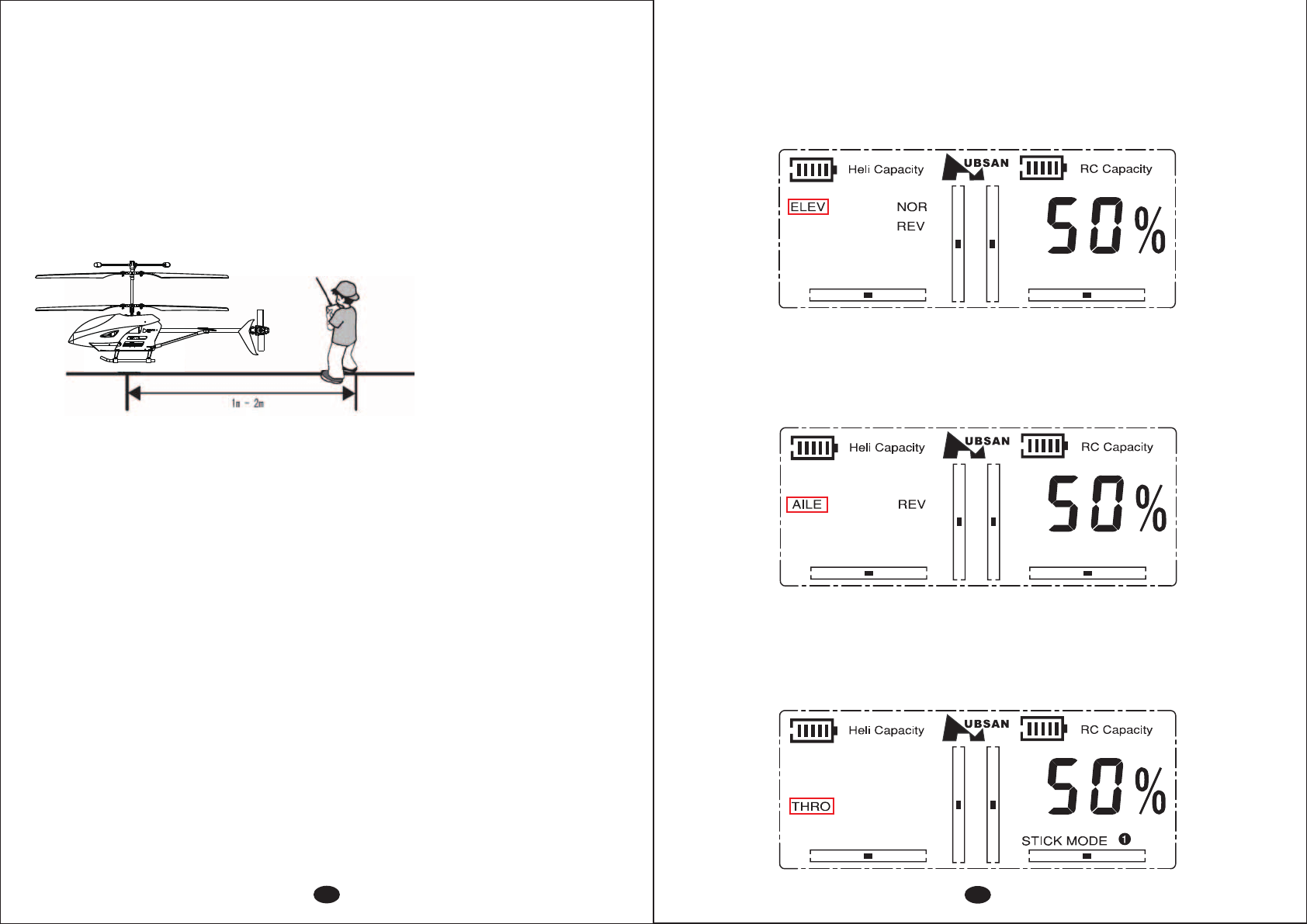
6
4.2 Reversing channel setup
4.2.1.ELEV REVERSE SET UP
Hold down ENT key for 1 second to enter the setting status, the ELEV symbol will
start to flash, the current status symbols, NOR or REV will be displayed. Press ENT
key to choose REV and then hold EXT for 2 seconds to confirm and exit.
flashing
4.2.2. AILE REVERSE SET UP
Hold down ENT key for 1 second to enter the setting status, and then press the DN
key, the AILE symbol will start to flash, the current status symbols, NOR or REV will
be displayed. Press ENT key to choose REV and then press EXT key for 2 seconds
to confirm and exit.
flashing
4.2.3. THRO REVERSE SET UP
Hold down the ENT key for 1 second to enter the setting status, and then press the
DN key twice, The THRO symbol will start to flash, the current status NOR or REV
will be displayed. Press ENT key to choose REV and then press EXT key for 2
seconds to confirm and exit.
flashing
13
Although the helicopter’s trim has been factory set, you will need to fine tune the
settings so that your helicopter can maintain a better balanced hover
IMPORTANT: KEEP YOUR CONTROL INPUTS VERY S-L-O-W & GENTLE
1. Set the collective Throttle joystick and trim slider to its lowest setting. All other
trim sliders should be at their mid positions.
2. After completing the ‘Power-On (Failsafe) Procedure’, place your model on a
smooth, flat surface which will allow it to slide and turn (a landing board is idea).
Tip: The helicopter will find the
rudder central automatically in
3 seconds after the helicopter
landing on the ground.
3. Keeping a safe 1 to 2 metres away from your model, always ready to switch off
the Throttle, S-L-O-W-L-Y advance the collective Throttle joystick until you can see
that the model’s landing skids are just trying to lift but are not yet hovering.
4. Observe how your helicopter behaves.
5. Most likely, your model will begin to Yaw (rotate) or Roll (topple to one side). It
may even show signs of an inclination to Pitch (Rock forwards or backwards) onto
its nose or tail.
6. Adjust the appropriate trim slider(s) to counteract any observed movement(s).
7. Once the trim sliders have balanced your helicopter, it is time to test the Rudder
response. Move the collective joystick S-L-O-W-L-Y to the Left/Right and verify that
your model is responding as shown in the ‘Effects of Controls’ illustration.
8. You will probably find you need to re-adjust the slider trim to get an equal
response from Left/Right Rudder inputs.
If your helicopter’s control response do not correspond to the behaviour described in
‘Effects of Controls’, check that your Servo Reverse switches are set correctly.
Note: we have not yet used the cyclic joystick controls (other than their trim sliders),
as these will tilt the helicopter, which may cause the lower rotors to touch the
ground. This would result in wear or damage.
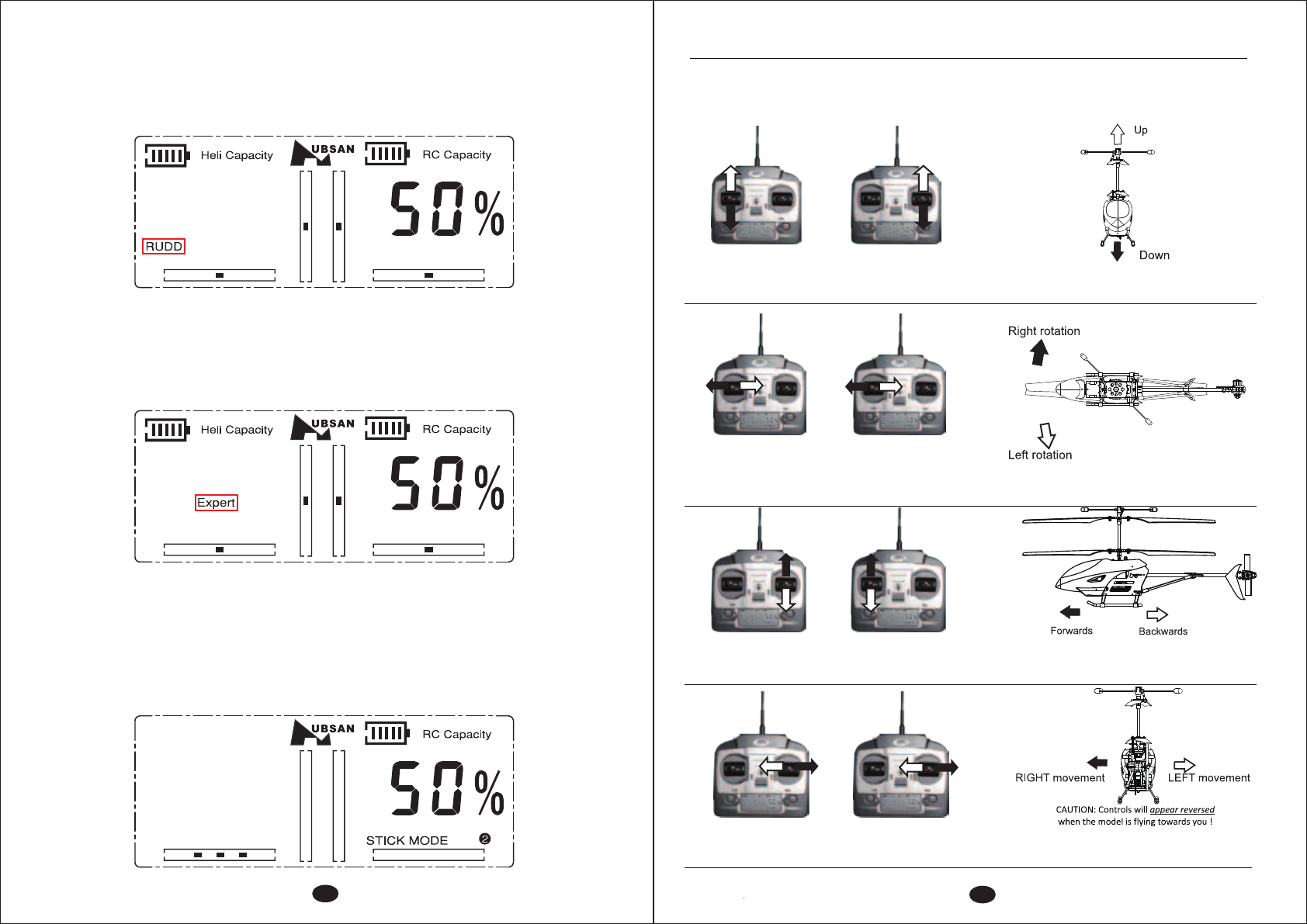
7
4.2.4. RUDD REVERSE SET UP
Hold down the ENT key for 1 second to enter the setting status, and then press the
DN key repeatedly until the RUDD symbol starts to flash, the current status NOR or
REV will be displayed. Press ENT key to choose REV and then press EXT key for 2
seconds to confirm and exit.
flashing
4.2.5. EXPERT MODE REVERSE SET UP
Hold down the ENT key for 1 second to enter the setting status, and then press the
DN key repeatedly until the EXPERT symbol starts to flash, the current status NOR
or REV will be displayed. Press ENT key to choose REV and then press EXT key for
2 seconds to confirm and exit.
flashing
4.3 SENSITIVITY SET UP
4.3.1 RUDDER SENSITIVITY SET UP- NOR MODE
Hold down the ENT key for 1 second to enter the setting status, and then press the
DN key repeatedly until the three-point dotted line symbol starts to flash(see
picture below), press RUDDER TRIM key to idea sensitivity and then press EXT
key for 2 seconds to confirm and exit.
12
EXT
UP
ENT
DOWN
EXT
UP
ENT
DOWN
EXT
UP
ENT
DOWN
EXT
UP
ENT
DOWN
6.2 Effect of Control
CAUTION: To avoid loss of control: ALWAYS move the controls S-L-O-W-L-Y! Be
aware that control inputs will reduce available lift (see ‘Helicopter Principles of
Flight’).Be ready to use a little extra Throttle to maintain height during maneuvers.
Throttle (Collective Power) increases/decreases the Flying Height of your helicopter
Rudder (Collective Torque Yaw) rotates your helicopter’s fuselage Left / Right
Elevator (Cyclic Pitch) moves your helicopter Forwards/Backwards
Aileron (Cyclic Roll) moves your helicopter ‘sideways’ Left/Right
MODE 2
MODE 2
MODE 2
MODE 2
EXT
UP
ENT
DOWN
EXT
UP
ENT
DOWN
EXT
UP
ENT
DOWN
EXT
UP
ENT
DOWN
MODE 1
MODE 1
MODE 1
MODE 1
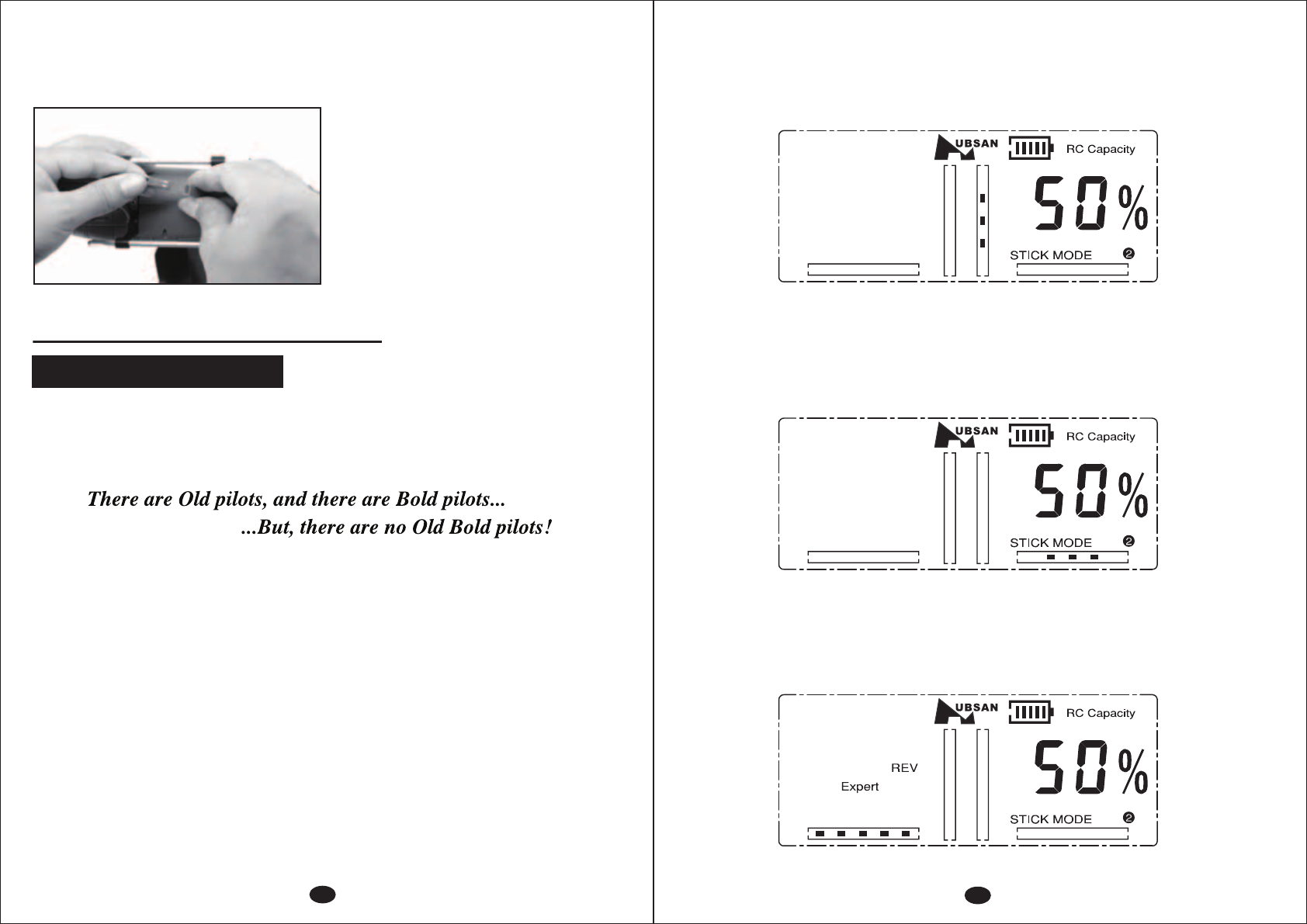
6. Flight Training
11
5.4 Fitting the LiPo battery
The supplied LiPo battery is mounted inside a cradle on the underside of your
helicopter’s fuselage.
The LiPo battery should be mounted
with its connecting cables facing
towards the rear or the helicopter
DO NOT connect the cables at this time
Your RC helicopter is an easy-to-fly model but, you don’t become an expert pilot
without taking time to learn the basics. As the saying goes:
In other words, if you don’t want your first few flights to end in a pile of mangled
wreckage-requiring expensive repairs to your new model – take the time to follow this
brief Flight Training Program. After all, learning to fly your helicopter is all part of the
enjoyment!
6.1 Power-On (Failsafe) Procedure
Your RC helicopter’s 4-in-1 Gyro Receiver is fitted with a Power-On failsafe.
This is designed to ensure that the helicopter’s motor will not start unless it detects a
suitable radio-control signal when the LiPo battery is connected. The correct Start-Up
sequence is as follows:
8
4.3.2. ELEV SENSIVITY SET UP- NOR MODE
Hold down the ENT key for 1 second to enter the setting status, and then press the
DN key repeatedly until the three-point dotted line symbol starts to flash(see picture
below), press ELEVATOR TRIM key to idea sensitivity and then press EXT key for 2
seconds to confirm and exit.
4.3.3 AILE SENSIVITY SET UP- NOR MODE
Hold down the ENT key for 1 second to enter the setting status, and then press the
DN key repeatedly until the three-point dotted line symbol starts to flash, press
AILERON TRIM key to idea sensitivity and then press EXT key for 2 seconds to
confirm and exit.
4.3.4 RUDDER SENSITIVITY SET UP- EXPERT MODE
Hold down the ENT key for 1 second to enter the setting status, and then press the
DN key repeatedly until the five-point dotted line symbol starts to flash(see picture
below), press RUDDER TRIM key to idea sensitivity and then press EXT key for 2
seconds to confirm and exit.
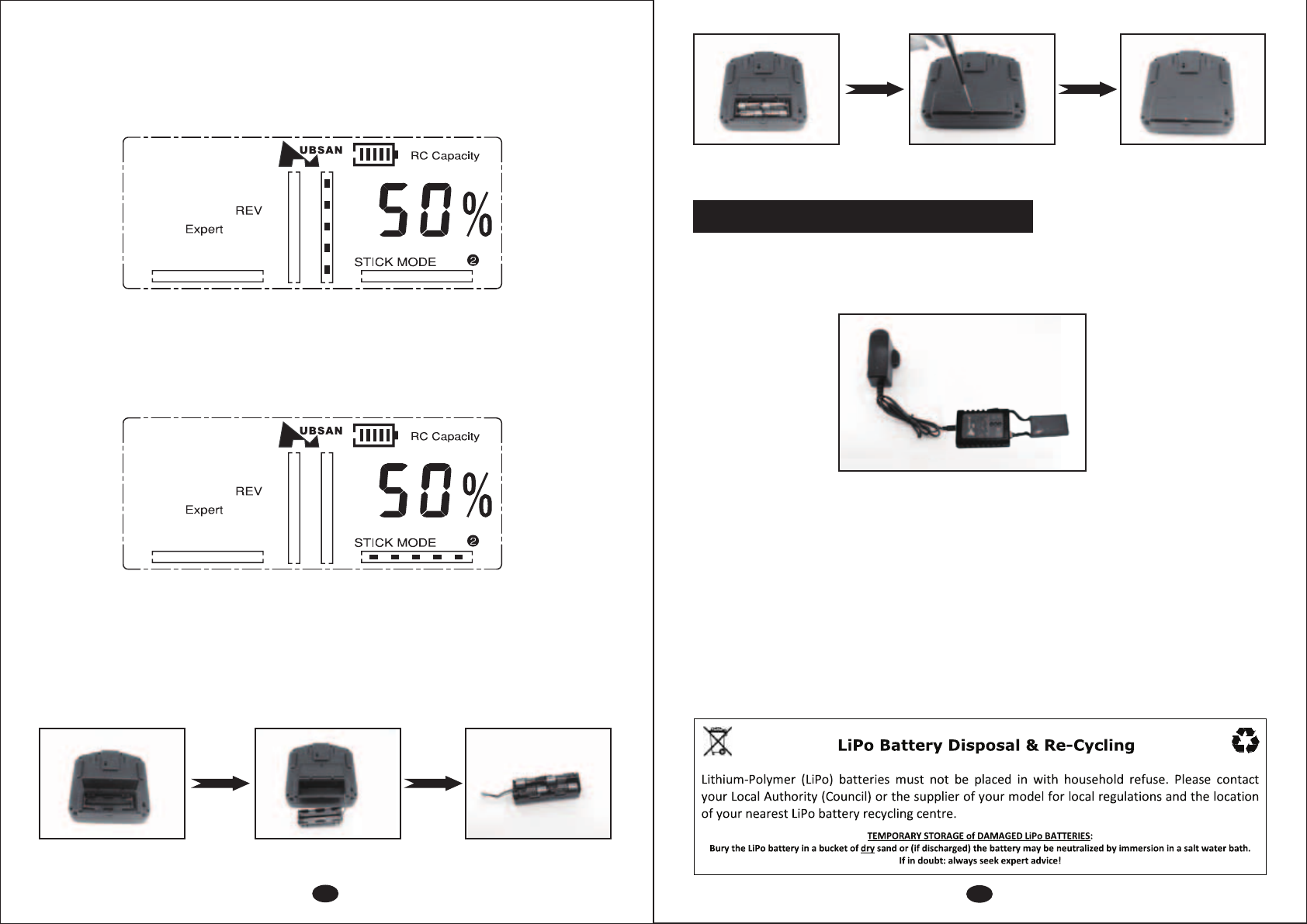
9
4.3Battery Mounting
Notice:
>Do not mix old and new batteries
>Do not mix different types of batteries
>Do not charge non-rechargeable battery.
Open the cover Take out the holder According to the correct
polarities,install 8 x AA battery
4.3.5. ELEV SENSIVITY SET UP- EXPERT MODE
Hold down the ENT key for 1 second to enter the setting status, and then press the
DN key repeatedly until the five-point dotted line symbol starts to flash(see picture
below), press ELEVATOR TRIM key to idea sensitivity and then press EXT key for
2 seconds to confirm and exit.
4.3.6 AILE SENSIVITY SET UP- EXPERT MODE
Hold down the ENT key for 1 second to enter the setting status, and then press the
DN key repeatedly until the five-point dotted line symbol starts to flash, press
AILERON TRIM key to idea sensitivity and then press EXT key for 2 seconds to
confirm and exit.
5 Li-Po Battery Charging
10
Insert the plug into Return the holder Fasten the screw
the power jack back to the compartment
5.1 The helicopter is equipped with a LiPo battery:
7.4V 2 Cell 650mAh x 1 unit (Fixed Pitch System)
5.2 Connect battery to balance charger and wall charger,The two led lights is red
whilst charging and turns green when charging is finished.
5.3.Please refer to 2.2. Safety Advisory Notice
Always partially charge your LiPo battery before storage. LiPo batteries retain a
charge over a reasonable period; It is not normally necessary to recharge stored LiPo
batteries unless stored for periods longer than 3-6 months.
If your LiPo battery has been over-discharged, it will not be possible to recharge it
again.
7.4V
FCC warning statement:
This equipment has been tested and found to comply with the limits for a Class B
digital device, pursuant to part 15 of the FCC Rules. These limits are designed to
provide reasonable protection against harmful interference in a residential installation.
This equipment generates, uses and can radiate radio frequency energy and, if not
installed and used in accordance with the instructions, may cause harmful interference
to radio communications. However, there is no guarantee that interference will not
occur in a particular installation. If this equipment does cause harmful interference to
radio or television reception, which can be determined by turning the equipment off
and on, the user is encouraged to try to correct the interference by one or more of the
following measures:
• Reorient or relocate the receiving antenna.
• Increase the separation between the equipment and receiver.
• Connect the equipment into an outlet on a circuit different from that to which the
receiver is connected.
• Consult the dealer or an experienced radio/TV technician for help.
Caution: Any changes or modifications to this device not explicitly approved by
manufacturer could void your authority to operate this equipment.
This device complies with part 15 of the FCC Rules. Operation is subject to the
following two conditions: (1) This device may not cause harmful interference, and (2)
this device must accept any interference received, including interference that may
cause undesired operation.
○
19